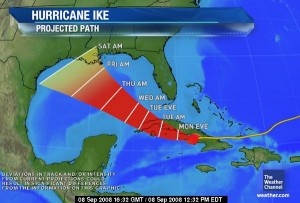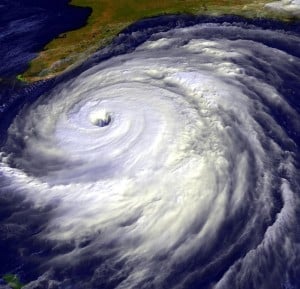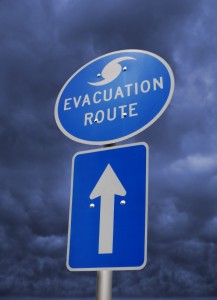Having lived on both the East Coast and the West Coast of the United States, I’ve had the unfortunate opportunity to experience both earthquakes and hurricanes. Neither is much fun. They both put lives in danger, break things, create massive traffic jams (I’ll save the story of my 100-mile, 18-hour “evacuation” from Charleston, SC for another time), and generally disrupt life for up to a few weeks. There’s one major difference between the two natural disasters, though: you can see a hurricane coming.
If the threat of earthquakes or hurricanes is a concern, you can choose to live on the opposite coast or in the middle of the country. Whichever part of the country you live in, though, you’ll have weather disruptions of some kind.
Businesses are much the same. However they are situated, none of them will ever have a perfect customer experience for every customer. The question is – will they keep their eyes open for storms that may arise, or will they pretend that the storms aren’t coming?
Some people prefer not knowing when an earthquake or other trouble is headed their way. Since they can’t change the outcome, they’d rather not know what’s coming. Others are planners, and would rather be able to see the hurricane coming and take action to minimize damage. They want to be forewarned so they can pack their bags, board up their windows, and collect bottled water.
Successful businesses keep an eye out for potential trouble they can predict and avert or minimize – or even turn into opportunities. They watch out for storms, and then they act.
Here are 4 main areas where businesses can ensure that they not only see the hurricane coming, but take the appropriate action.

1. Like any good weather person, you first need to know where to look. You can have the best early warning system in the world, but if you point your weather satellite at the wrong spot, (say, the Mojave Desert) you’re not going to see any approaching hurricanes. Likewise, you need to know where your customers interact with your brand.
Customer journey mapping (CJM) is a great way to understand the path your customers take on the way to purchasing your product or service. CJM can be accomplished in a variety of ways, but one of the best is to assemble frontline workers from multiple areas that touch the customer. That might be sales, the web team, your customer service/contact center and others. Get their perspective of the customer’s journey and then validate & expand your perception of that journey with actual customers. Focus groups and individual interviews work well to learn more about your customers’ journey from their perspective.
2. Once meteorologists know where to look for hurricanes, the next thing they do is evaluate their strength. In a similar fashion, once you know where your customers are interacting with you, it’s time to better understand that experience. Quantitative studies are often a logical next step after journey mapping. The map informs where you should evaluate the experience and also gives you clues into what questions you should ask. In your CJM sessions, you’ll uncover customer sentiment associated with various touchpoints. Use that knowledge to ask more insightful questions on your quantitative study to better understand exactly how your customers feel about their experience. 
3. Now that you have statistics about your customers’ attitudes toward their experience, it’s time to make sense of the data. When evaluating a hurricane, meteorologists build models to understand its projected path. Will it hit a populated area? How big will the storm surge be? In other words, how much does it matter that this hurricane is developing in the Atlantic?

Businesses have to do the same thing. You can’t solve for every negative customer experience; you need to prioritize your efforts based on where the customers’ concerns will have the most impact on your business. That’s where an analysis of the true drivers of your key metrics comes into play. Take the customer feedback you collected in your quantitative survey and statistically correlate it to the things that matter most to you. That might be Net Promoter Score, retention, new sales, etc. The touchpoints that need improvement, correlate well to your desired outcomes and aren’t impossible to fix are the places to prioritize your efforts.
4. The whole point of knowing where to look for a hurricane, analyzing its strength and projecting its potential course is so you can batten down the hatches or get out of the way! Likewise, you don’t map your customers’ journey, ask insightful questions and link survey results to financial outcomes to say, “Hmmm … that’s interesting.” You do it improve your customers’ experience and improve your financial wellbeing. You do all those things to take action and take action fast!
Just like it wouldn’t make sense for meteorologists to look for storms only once each spring, it also doesn’t make sense for you to evaluate your customers’ experience only once per year. The days when a company could get by with only one annual survey are gone. Instead, many companies are continuously evaluating customer feedback and then getting that information into the hands of the people who can do something about it as quickly as possible. CX-specific Software as a Service (SaaS) platforms are ideal for housing customer data, evaluating it, and then sending hot alerts to employees so that they can react to the news. These companies are saving customers because they have preemptive warning before the CX storm happens, just like beachside communities in the path of a hurricane can prepare their homes.
Is a hurricane of negative customer sentiment headed your way? If so, can you see it coming, do you think it’ll matter, and are you able to do something about it? If not, I suggest you put some or all of these mechanisms in place so you’ll know how to weather the storm and emerge as a better, stronger business, with a proactive CX strategy.
Full disclosure: I work for MaritzCX who does customer journey mapping, quantitative studies, true driver analysis and has a SaaS platform. If you’d like, we can help with each of these items. If not, that’s ok too. At the end of the day, we’re all customers and I want our experiences to be awesome – regardless of who made them that way.
Image credits:
Satellite: http://www.tempusglobaldata.com/21-year-usu-veteran-joins-tempus-global-data-team/
Weather radar image: https://simple.wikipedia.org/wiki/Weather_radar
Hurricane path: http://www.islandreal.com/blog/hurricane-ike-could-be-an-uninvited-guest-to-anna-maria-island/
Evacuation sign: http://a0130905.uscgaux.info/news.htm





